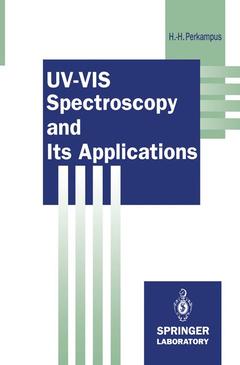Description
UV-VIS Spectroscopy and Its Applications, Softcover reprint of the original 1st ed. 1992
Springer Lab Manuals Series
Author: Perkampus Heinz-Helmut
Language: English
Subjects for UV-VIS Spectroscopy and Its Applications:
Publication date: 01-2012
244 p. · 15.5x23.5 cm · Paperback
244 p. · 15.5x23.5 cm · Paperback
Description
/li>Contents
/li>
UV-VIS spectroscopy is one of the oldest methods in molecular spectroscopy. The definitive formulation of the Bouguer-Lambert Beer law in 1852 created the basis for the quantitative evaluation of absorption measurements at an early date. This led firstly to colorimetry, then to photometry and finally to spectrophotometry. This evolution ran parallel with the development of detectors for measuring light intensities, i.e. from the human eye via the photo element and photocell, to the photomultiplier and from the photo graphic plate to the present silicon-diode detector both of which allow simultaneous measurement of the complete spectrum. With the development of quantum chemistry, increasing atten tion was paid to the correlation between light absorption and the structure of matter with the result that in recent decades a number of excellent discussions of the theory of electronic spectroscopy (UV-VIS and luminescence sp,~ctroscopy) have been published. Consequently, this extremely ivteresting aspect of molecular spec troscopy has dominated the teaching of the subject both in my own lectures and those of others. However, it is often overlooked that, in addition to the theory, applications of spectroscopic methods are of particular interest to scientists. For this reason, a lecture series about electronic spectroscopy given in the Institute for Physical Chemistry at the Heinrich-Heine-University in Dusseldorf was supplemented by one about "UV-VIS spectroscopy and its applications". This formed the basis of the present book.
1 Introduction.- 2 Principles.- 2.1 The Bouguer-Lambert-Beer Law and Its Practical Application.- 2.2 Primary Photophysical Processes.- 2.3 Vibrational Structure of Electronic Spectra.- 2.4 Electronic Spectra and Molecular Structure.- References.- 3 Photometers and Spectrophotometers.- 3.1 Photometers.- 3.2 Spectrophotometers.- 3.3 The Stray Light Error.- 3.4 Light Sources for UV-VIS Spectroscopy.- References.- 4 Analytical Applications of UV-VIS Spectroscopy.- 4.1 Photometric Determination of a Single Substance.- 4.2 Multicomponent Analysis.- 4.3 Identification and Structure Determination.- 4.4 Chemometrics.- References.- 5 Recent Developments in UV-VIS Spectroscopy.- 5.1 Dual-Wavelength Spectroscopy.- 5.2 Derivative Spectroscopy.- 5.3 Reflectance Spectroscopy.- 5.4 Photoacoustic Spectroscopy.- 5.5 Luminescence-Excitation Spectroscopy.- References.- 6 Investigation of Equilibria.- 6.1 General.- 6.2 Protolytic Equilibria; pK-Values.- 6.3 Complex-Forming Equilibria.- References.- 7 Investigation of the Kinetics of Chemical Reactions.- 7.1 Fundamental Equations of Kinetics.- 7.2 The Number of Linearly Independent Partial Reactions.- 7.3 Evaluation of Kinetic Measurements.- 7.4 Examples.- 7.5 Fast Reactions.- 7.6 Photoreactions.- 7.7 Spectrometers for Kinetic Measurements.- 7.8 Determination of the Spectra of Intermediates.- References.- 8 Evaluation of UV-VIS Spectral Bands.- 8.1 Oscillator Strength and Transition Moment.- 8.2 Band Analysis.- 8.3 Vibrational Structure.- References.- Index of Illustrated Absorption Spectra.
© 2024 LAVOISIER S.A.S.




